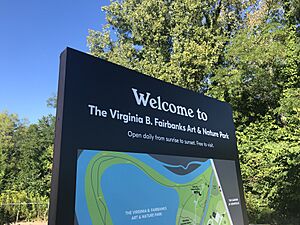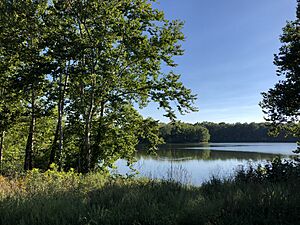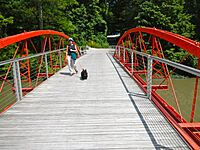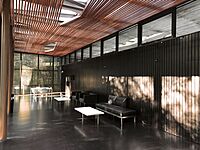- This page was last modified on 17 October 2025, at 10:18. Suggest an edit.
Virginia B. Fairbanks Art & Nature Park: 100 Acres facts for kids
| Virginia B. Fairbanks Art & Nature Park | |
|---|---|
| 100 Acres, Fairbanks Park | |

Park entrance signage in 2022
|
|
| Type | Nature park Sculpture park |
| Location | Indianapolis, Indiana, U.S. |
| Area | 100 acres (40 ha) |
| Designer | Edward L. Blake, Jr. |
| Owned by | Indianapolis Museum of Art |
| Open | Daily, sunrise to sunset |
| Status | Open all year |
| Parking | 40-space lot |
| Bicycle facilities | |
| Facilities | Ruth Lilly Visitors Pavilion |
The Virginia B. Fairbanks Art & Nature Park is a cool place in Indianapolis, Indiana, USA. People also call it the 100 Acres or Fairbanks Park. It's a public park where you can see and interact with art, and it's part of the Newfields (Indianapolis Museum of Art) campus.
This park opened in 2010. It covers 100-acre (40 ha) and is one of the biggest parks of its kind in the United States. When it first opened, it had eight special artworks made just for that spot by artists from all over the world. The park also has walking paths, beautiful natural areas, and a building called the Ruth Lilly Visitors Pavilion. It's free to visit and open from sunrise to sunset every day.
The park is located near the Indianapolis Museum of Art. It has lots of natural features like woods, meadows, wetlands, and a large lake that used to be a quarry. The park is named after Virginia B. Fairbanks, whose husband, Richard M. Fairbanks, was a big supporter.
Contents
Park History
From Quarry to Park
Before it was a park, this area was a gravel quarry. Workers dug out gravel here when they were building Interstate 65. The company that did the digging, Huber, Hunt & Nichols, later gave the land to the Indianapolis Museum of Art in 1972. For many years after that, the old quarry site was mostly left untouched.
People started using the site informally, even though it wasn't officially open. So, in 1999, the museum worked with other groups to open the area to the public. They started taking care of the paths and removing plants that didn't belong there. The museum also made a big plan to turn the site into a public art and nature park.
Designing the Park
In 2004, the museum hired landscape architect Edward L. Blake, Jr. and architect Marlon Blackwell to design the park. They wanted the design to highlight the park's natural beauty. The Richard M. Fairbanks Foundation gave the museum $15 million in 2001 and 2006 to help pay for the park's early costs. In 2007, the museum announced the first ten artists whose artworks would be placed in the park.
Some parts of the park's original plan were changed in 2008. For example, a long walkway designed by artist Mary Miss was canceled because it was too expensive and might harm the environment. Miss was asked to create a different artwork that would be more gentle on nature. The Ruth Lilly Visitors Center was also made smaller. Some artists had to delay their involvement, and Jeppe Hein was added to the list of artists for the opening.
When they started building the park on September 18, 2008, the director of the Indianapolis Museum of Art, Maxwell L. Anderson, said they wanted to let nature stay in charge of the area. The park was supposed to open in September 2009, but it was delayed because of money problems in the country. Finally, the park opened to the public on June 20, 2010.
Park Improvements and New Art
In 2017, a new plan was made for the entire Newfields campus, which includes the park. This plan suggested adding a new footbridge over the Indiana Central Canal and a tree-lined path to connect different parts of the campus to the lake in the park.
In 2019, the Richard M. Fairbanks Foundation gave Newfields another $10 million. This money was for park upgrades like better paths for walking and biking, more restrooms, and extra parking. It also helped create a fund to keep the park maintained and add new art.
In January 2023, Newfields announced a new art show called "Home Again." This show added three new artworks to the park: Oracle of Intimation by Heather Hart, The Pollinator Pavilion by Mark Dion and Dana Sherwood, and This is NOT a Refuge by Anila Quayyum Agha. These new artworks were installed in June 2023.
Art Collection
The Virginia B. Fairbanks Art & Nature Park is home to many interesting artworks. Some of these are permanent, while others have been displayed for a time and then moved.
Current Artworks
These are some of the artworks you can see in the park right now:
- Bench Around the Lake (2010) by Jeppe Hein
- Free Basket (2010) by Los Carpinteros
- Funky Bones (2010) by Joep van Lieshout
- Park of the Laments (2010) by Alfredo Jaar
- Stratum Pier (2010) by Kendall Buster
- Team Building (Align) (2010) by Type A
Past Artworks
These artworks were once displayed in the park:
- Chop Stick (2012) by visiondivision
- Eden II (2010) by Tea Mäkipää
- FLOW: Can You See the River? (2011) by Mary Miss
- Indianapolis Island (2010) by Andrea Zittel
- NOTICE: A Flock of Signs (2013) by Kim Beck
Park Features
Waller Bridge
The Waller Bridge is a special footbridge that crosses the Indiana Central Canal. It lets people walk between the park and the rest of the Newfields campus. This bridge was originally built in 1873 in another county in Indiana. It was later moved to its current spot and fixed up with some modern touches.
Paths and Transportation
The Central Canal Towpath is a path made of crushed limestone that runs along the eastern edge of the park, next to the canal. This path is great for walkers and bikers. It connects the park to other trails like the Monon Trail and the Fall Creek Greenway. You can find bicycle parking racks and a station for Indiana Pacers Bikeshare bikes at the park.
If you come by car, there's a parking lot with 40 spaces. You can get to it from W. 38th St. A crosswalk leads visitors from the parking lot to the park's main entrance.
Ruth Lilly Visitors Pavilion
The Ruth Lilly Visitors Pavilion was designed by architect Marlon Blackwell in 2004. The building looks like a fallen leaf and uses wood, glass, and steel. It's designed to be good for the environment, saving water and energy. This 1,290-square-foot (120 m2) building is located in the park's woods. It has a room for different activities and restrooms. The pavilion has won awards for its design. In 2021, experts said it was one of the ten most important buildings built in Indianapolis since World War II.
Wild Birds Unlimited Native Pollinator Meadow
The pollinator meadow was created with money from a $10 million grant in 2019. This meadow helps pollinators like bees and butterflies. Other donations also helped fund the meadow and other efforts to protect nature in the park.
More to Explore
- List of sculpture parks
- List of outdoor artworks at Newfields
- List of parks in Indianapolis
- List of attractions and events in Indianapolis




